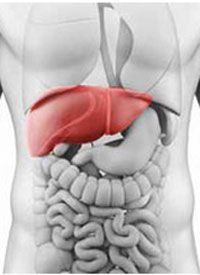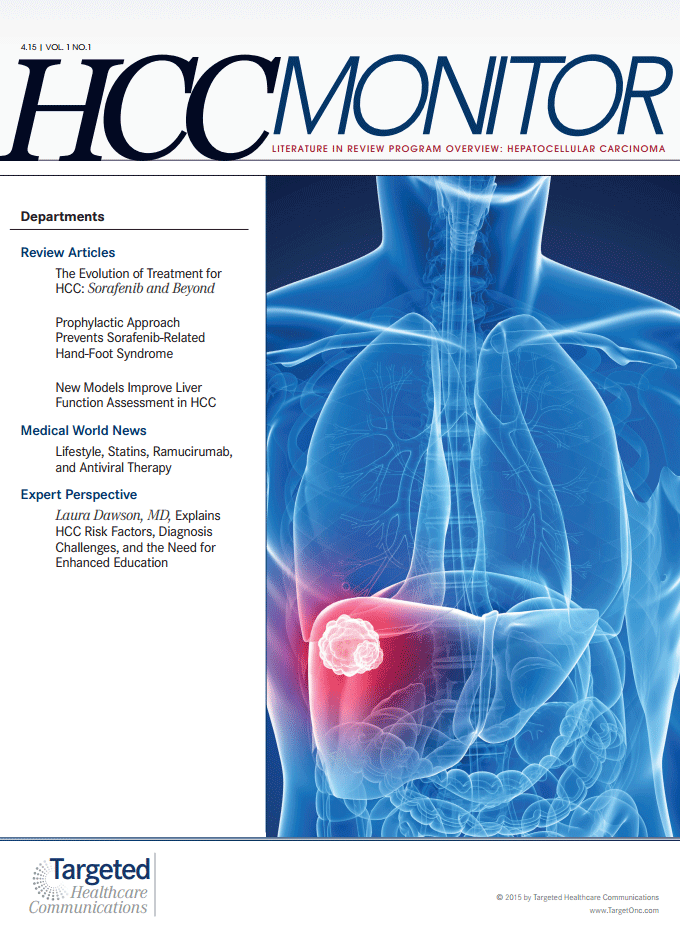New Model Improves Liver Function Assessment in HCC
A novel, evidence-based model for staging liver function in the setting of hepatocellular carcinoma may offer improved guidance in the selection of appropriate, patient-specific therapeutic strategies.

A novel, evidence-based model for staging liver function in the setting of hepatocellular carcinoma (HCC) may offer improved guidance in the selection of appropriate, patient-specific therapeutic strategies. A recent publication in theJournal of Clinical Oncology, by Philip J. Johnson, MD, and colleagues from the department of molecular and clinical cancer medicine at the University of Liverpool in the United Kingdom, reported that the novel Albumin-Bilirubin (ALBI) grade performed at least as well as the traditional Child-Pugh (CP) score, while eliminating the need for subjective variables.1
The Importance of Staging in Treatment Decisions
Treatment decisions and prognosis often rely heavily on proper staging of the tumor and assessment of a patient’s liver function. This is especially true given the increasing trend in earlier presentation and confounding liver disease.
“It is widely perceived that survival in HCC depends on tumor stage, underlying liver function, and…performance status,” Johnson and colleagues wrote in their recent report. As a result, the availability of reliable measurement tools for staging HCC and liver function are of pivotal importance in guiding therapeutic decisions.
Several systems have been described and compared for the staging of HCC, including Okuda, Cancer of the Liver Italian Program, TNM, Chinese University Prognostic Index, Japanese Integrated Staging Score, and the Barcelona Clinic Liver Cancer (BCLC) system.2-5The evidence-based BCLC treatment algorithm, which considers tumor stage, performance status or cancer-related symptoms, and liver function, is perhaps the most widely accepted.6,7
In the BCLC system, very early and early stage disease (stage O or A, respectively) are considered amenable to curative approaches. Stage B, intermediate disease, focuses on locoregional therapy with the goal of controlling progression. Patients with advanced stage C disease have been shown to benefit from the multikinase inhibitor therapy, sorafenib; although macrovascular tumor invasion and/or metastases are present, liver function remains preserved. In the terminal, or stage D, setting, HCC patients with severe cancer symptoms or clearly decompensated liver cirrhosis are mainly offered palliative care.
Assessing Liver Function: The Need for an Objective Model
The BCLC treatment algorithm defines the element of liver function using the patient’s Child-Pugh (CP) score. This scoring system, developed in the 1960s for assessing the prognosis of variceal bleeding surgery in cirrhotic patients with portal hypertension,8,9has become widely accepted for rating presurgical hepatic reserve. In more recent years, the CP score has also gained acceptance for gauging hepatic reserve in the setting of advanced HCC, particularly in the selection of clinical trial candidates for new treatment strategies.
The relevance of the CP score in patient stratification, however, has been questioned by some in the field.10“Many have concerns as to whether [the CP score] stratifies disease appropriately for novel therapies,” wrote Jennifer Knox, MD, from the University of Toronto, Princess Margaret Cancer Centre, in an editorial accompanying Johnson’s piece in theJournal of Clinical Oncology.11Johnson’s publication corroborated this sentiment, noting that “it is not clear that the CP grade is appropriate for assessing liver function [or] dysfunction in patients with HCC.”1
The CP score itself consists of 5 components: albumin, bilirubin, international normalized ratio, ascites, and encephalopathy. A cumulative score across all categories assigns patients to a CP class of A, B, or C, where the 1-year survival prediction decreases successively from 100% in CP-A, to 45% for those with CP-C grade liver disease.12
Critics of the CP scoring system note that individual parameters are scored based upon arbitrary cutoff points “without formal statistical grounding,” added Johnson.1As low serum albumin also leads to ascites, some would suggest that the potential for double counting of interrelated variables is one weakness of this method.
Moreover, the subjectivity of 2 of the score’s components, ascites and encephalopathy, may present another limitation. “There are no clear guidelines for distinguishing between mild and moderate ascites and/or the impact of diuretic therapy [on scoring],” wrote Johnson.1“The impact of the tumor on the pathogenesis of the ascites is not clear.”
While it is difficult to distinguish between liver dysfunction and tumor, critics claim that “the CP score may not discriminate sufficiently regarding influence on drug-related toxicity or benefits,” added Knox.11The majority of HCC patients are categorized by a CP score of A,13which leaves little room for patient stratification.
The ALBI Grade: A New Model for Improved Liver Function Assessment
In response to the deficiencies in current CP scoring and HCC staging conventions, Johnson and colleagues pooled patient data through a network of international collaborations in an effort to define a unifying liver function score applicable to heterogeneous populations.1More than 6000 patients, spanning Europe, Japan, China, and the United States, were analyzed for important HCC prognostic factors. Not surprisingly, the majority of participants were classified as CP score A.
Efforts of this international collaboration led to the development of the ALBI model, an algorithm involving serum albumin and bilirubin levels as the only 2 variables.1The ALBI score involves 3 levels of stratification, ALBI 1, 2, and 3, each representing successive risk categories for liver function.
Overall, findings of the study indicate that the ALBI categories compare favorably with the CP scoring convention in terms of prognosis. Additionally, they provide added benefit by substantially improving ease of use in a clinical setting.
By emphasizing preservation of only 2 common laboratory values, the ALBI grade offers a more simplistic model, which is also more objective, easier to use in clinical practice, and has the advantage of being validated in a large, diverse patient population.
“Although the performance of ALBI is similar to that of CP, the fact that it is evidence- based, much simpler…and entirely objective will make it easier to implement,” wrote Johnson.1“Furthermore, relying on fewer variables, it may be more readily applicable in large-scale international studies.”
Further Stratifying Patients With CP Score A
Taking a closer look at the ALBI grade, Knox’s editorial explained, “The intersection of these two commonly measured laboratory values [albumin and bilirubin] categorizes patients into one of three prognostic groups. Perhaps more importantly,” Knox continued, “the ALBI model subclassifies the CP-A groups from the various geographic regions into two distinct survival cohortsALBI 1 and ALBI 2.”11
The CP-A classification has recently become a standard inclusion criterion for patients enrolled in most advanced HCC drug trials. This began after the pivotal Sorafenib HCC Assessment Randomized Protocol trial demonstrated prolonged survival in sorafenib-treated, advanced HCC patients, who were BCLC stage C and CP-A at the time of enrollment.14
In Johnson’s recent publication, investigators demonstrated that the ALBI grade could divide CP-A patients even further, into 2 different prognostic groups. With ALBI, patients categorized as ALBI 2 demonstrated a less favorable prognosis, with a median survival of 14 months, while those in ALBI 1 had a better prognosis, reaching an extended median survival of 26 months.1
“Our findings suggest that not all CP grade A patients are the same and that this heterogeneity may have an impact on survival findings,” wrote Johnson.1In fact, some feel that the findings “should provide leverage to change the evaluation of underlying liver function in the setting of advanced HCC,” noted Knox.11
Should the ALBI model begin to replace the CP score in future clinical trials, safety measures will need to be carefully devised. The inclusion of ALBI 2 patients could have some crossover with the CP-B score, rather than CP-A, for which there is less cumulative experience in historic clinical trials. Interim safety assessments would need to be performed frequently in this setting.
The inclusion of a subset of CP-B patients would also present a challenge in the interpretation of data from these trials. “Trial assumptions and outcomes for survival…may change because of this inclusion amendment, but this only provides further argument for randomization and stratifications as part of good design,” Knox added.11
Further prognostic stratification among HCC patients not only has important implications for ongoing clinical trials, but also for the review of those that have already been completed. Should historic serum albumin and bilirubin values be available, a secondary analysis of the data in light of the ALBI grade “may highlight a subset of patients in whom a therapy has more significant impact than was demonstrated,” wrote Knox.11
“New hypotheses may now appear if already completed trials are reviewed through the ALBI lens,” Knox explained. “Perhaps additional subsets in published first- and second-line drug trials will surface in which benefits were previously masked.”11
Other scoring systems may also be considered as alternatives to the CP and ALBI grades. The Model for End-Stage Liver Disease, or MELD score, for instance, has been used to stratify patients with end-stage cirrhosis.12In this case, however, the MELD score may not be applicable to all patients with HCC, as most do not display end-stage cirrhosis of the liver when first presenting with the disease.
Future Directions in the Field
Overall, the proper assessment of liver function and staging of HCC is critical to arriving at appropriate therapeutic decisions for patients with HCC and has important prognostic value. According to Knox, the findings of this internationally collaborative trial have made important strides in tackling a “complex clinical problem that has been in need of clarification for decades.”11
“The ALBI approach will avoid inter-observer variation and may highlight distinct prognostic subgroups within CP grade A,” Johnson and colleagues pointed out in their discussion.1They noted that “all these advantages are important considerations in the clinical trial setting.” Knox added that she “would welcome the replacement of CP-A score as a trial inclusion criterion by ALBI 1 and 2, as long as we proceed with appropriate safety reviews.”11
References:
1. Johnson PJ, Berhane S, Kagebayashi C, et al. Assessment of liver function in patients with hepatocellular carcinoma: a new evidence-based approach-the ALBI grade.J Clin Oncol. 2015;33(6):550-558.
2. Marrero JA, Fontana RJ, Barrat A, et al. Prognosis of hepatocellular carcinoma: comparison of 7 staging systems in an American cohort.Hepatol Baltim Md. 2005;41(4):707-716. doi:10.1002/hep.20636.
3. Lu W, Dong J, Huang Z, Guo D, Liu Y, Shi S. Comparison of four current staging systems for Chinese patients with hepatocellular carcinoma undergoing curative resection: Okuda, CLIP, TNM and CUPI.J Gastroenterol Hepatol. 2008;23(12):1874-1878.
4. Kudo M, Chung H, Haji S, et al. Validation of a new prognostic staging system for hepatocellular carcinoma: the JIS score compared with the CLIP score.Hepatol Baltim Md. 2004;40(6):1396-1405.
5. Kitai S, Kudo M, Minami Y, et al. Validation of a new prognostic staging system for hepatocellular carcinoma: a comparison of the biomarker-combined Japan Integrated Staging Score, the conventional Japan Integrated Staging Score and the BALAD Score.Oncology. 2008;75(suppl 1):83-90.
6. Llovet JM, Brú C, Bruix J. Prognosis of hepatocellular carcinoma: the BCLC staging classification.Semin Liver Dis. 1999;19(3):329-338.
7. Forner A, Reig ME, de Lope CR, Bruix J. Current strategy for staging and treatment: the BCLC update and future prospects.Semin Liver Dis. 2010;30(1):61-74.
8. Child CG, Turcotte JG. Surgery and portal hypertension.Major Probl Clin Surg. 1964;1:1-85.
9. Pugh RN, Murray-Lyon IM, Dawson JL, Pietroni MC, Williams R. Transection of the oesophagus for bleeding oesophageal varices.Br J Surg. 1973;60(8):646-649.
10. Durand F, Valla D. Assessment of prognosis of cirrhosis.Semin Liver Dis. 2008;28(1):110-122.
11. Knox JJ. Addressing the interplay of liver disease and hepatocellular carcinoma on patient survival: the ALBI scoring model.J Clin Oncol. 2015;33(6):529-531.
12. Cholongitas E, Papatheodoridis GV, Vangeli M, Terreni N, Patch D, Burroughs AK. Systematic review: the model for end-stage liver diseaseshould it replace Child-Pugh’s classification for assessing prognosis in cirrhosis?Aliment Pharmacol Ther. 2005;22(11-12):1079-1089.
13. Johnson P, Berhane S, Satomura S. An international collaborative study assessing the role of aetiology and stage in survival in HCC: implications for screening. 2014;60(1 suppl):S45-S46.
14. Llovet JM, Ricci S, Mazzaferro V, et al. Sorafenib in advanced hepatocellular carcinoma.N Engl J Med. 2008;359(4):378-390.

Survivorship Care Promotes Evidence-Based Approaches for Quality of Life and Beyond
March 21st 2025Frank J. Penedo, PhD, explains the challenges of survivorship care for patients with cancer and how he implements programs to support patients’ emotional, physical, and practical needs.
Read More